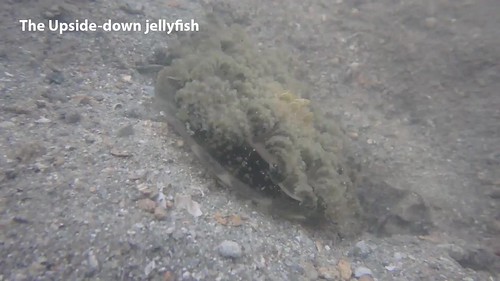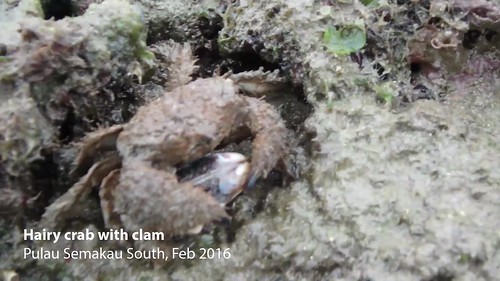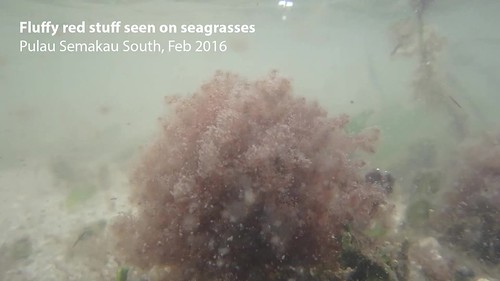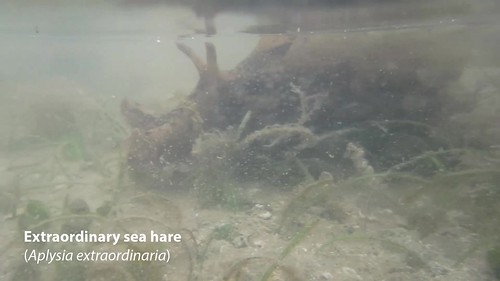We saw lots of sea hares, many Giant carpet anemones as well and checked on the seagrasses and coral bleaching. But the highlight of the trip for me were the many gentle friendly Dog-faced water snakes that were out and about in the overcast gloomy afternoon. These snakes are usually only more active at night.
Here's a video clip showing why its good to have protruding eyes if you are a water snake.
Russel found this lovely Orange sand star. It has a bright orange underside. There were also many Common sea stars. Kok Sheng also found all kinds of other beautiful and interesting sea stars.
There were also many Garlic bread sea cucumbers, most of them small, very few medium sized. I saw one Durian sea cucumber and one Long black sea cucumber. Nick found the special Brown sea cucumber.
There were also some very long lumpy Big synaptid sea cucumbers.
Pulau Semakau is one of the few places where we can commonly see the Upside-down jellyfish.
This little Hairy crab was clutching a clam and scuttled into a hole with it.
As the tide wasn't very low and the water was murky, we couldn't go to the reef edge. But the few corals I did see were not really bleaching.
Most of the Giant carpet anemones were OK. I didn't come across any anemonefishes, although some of them had anemone shrimps. Most of the Frilly sea anemones were OK too.
But I saw a few Giant carpet anemones and Frilly sea anemones that were very pale or yellowish, probably starting to bleach?
On the way to the shore, I noticed the corals growing on the side of the Marina at Keppel Bay were still alright.
Alas, I did not see any long Tape seagrass. Most of them were still cropped short, not much different from our last trip here in July 2015.
Spoon seagrasses with small leaf blades covered much of the area, with patches of other seagrasses like Noodle seagrass and others with ribbon like leaf blades.
There were also many small clumps of this Fuzzy green seaweed.
The large dead tree in the mangroves is starting to fall apart. The seagrasses are covered with lots of brown fluffy stuff. Which is probably why there were so many sea hares on the shore today? Because sea hares are said to eat such growths.
Here's a video clip of the fluffy stuff.
The sea hares were hunkered down in the mud to keep wet during the low tide. Many were in pairs. It turned out that there were two kinds of sea hares on the shore!
One of the sea hares is the Black-tailed sea hare with has a black tip on its foot and has many eye-shaped spots on its body. The inside of its flappy 'wings' are dark with large white spots.
Here's a video clip of the Black-tailed sea hare.
The other kind of sea hare was the Extraordinary sea hare which has small spots all over its body. The inside of its flappy 'wings' are dark with white blotchy bars.
Here's a video clip of the Extraordinary sea hare.
On the sand bar there were signs of burrowing crabs. And also of Olive snails.
Very close to this shore is Singapore's only southern fish farm which is said to be the largest fish farm in Singapore.
We have noticed many disturbing impacts of this fish farm on the natural shores of Pulau Semakau, see the post after our trip on Aug 2014. Yesterday, we saw some signs of impact. I'll share the details in a separate blog post.
Pulau Semakau is NOT the same as the Semakau Landfill. The Landfill was created by destroying all of Pulau Saking, and about half of the original Pulau Semakau by building a very long seawall. Fortunately, the landfill was constructed and is managed in such a way that the original mangroves, seagrass meadows and reefs on Pulau Semakau were allowed to remain. The eastern shore of Pulau Semakau is right next to the seawall of the Semakau Landfill, opposite the petrochemical plants on Pulau Bukom.

As the existing half of the Landfill was used up, the Phase 2 of the Landfill was just recently launched. This involved closing the gap of the seawall on the Semakau Landfill, forming one big pool where incinerated ash will be dumped. NEA worked to limit the damage to natural shores during the construction work for this expansion of the landfill.
Photos by others on this trip
- Loh Kok Sheng on his blog.
- Juria Toramae on facebook.
- Jianlin Liu on facebook.
- Heng Pei Yan on facebook.
- Sg Beachbum's blog.
- Chay Hoon on facebook.
- Russel Low on facebook.

























